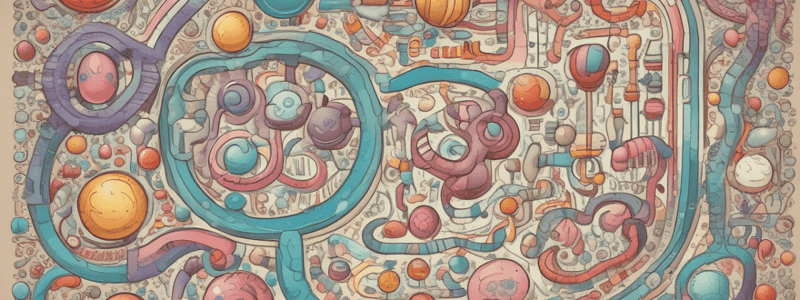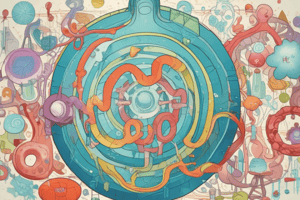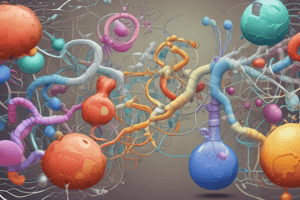Podcast
Questions and Answers
What is the primary reason for the dietary requirement of protein?
What is the primary reason for the dietary requirement of protein?
- To replace lost amino acids and allow for tissue repair (correct)
- To store protein in the body
- To synthesize all 20 amino acids
- To provide energy for the body
What is the recommended daily intake of protein?
What is the recommended daily intake of protein?
- 100-150 g
- 30-50 g
- 70-100 g
- 50-70 g (correct)
What happens to surplus amino acids in a well-fed individual?
What happens to surplus amino acids in a well-fed individual?
- They are stored in the body for later use
- They are used to synthesize new amino acids
- They are rapidly catabolised and the nitrogen excreted as urea (correct)
- They are converted into energy
Which of the following amino acids can be synthesized by humans from other intermediates?
Which of the following amino acids can be synthesized by humans from other intermediates?
What is the state of nitrogen balance in which protein synthesis exceeds the rate of breakdown?
What is the state of nitrogen balance in which protein synthesis exceeds the rate of breakdown?
What is the consequence of prolonged negative nitrogen balance?
What is the consequence of prolonged negative nitrogen balance?
In which of the following situations is a positive nitrogen balance necessary?
In which of the following situations is a positive nitrogen balance necessary?
What is the primary form of nitrogen excreted in the urine?
What is the primary form of nitrogen excreted in the urine?
What is the primary purpose of amino acids in the body?
What is the primary purpose of amino acids in the body?
What is the average daily turnover of proteins in an adult?
What is the average daily turnover of proteins in an adult?
Which of the following proteins has a half-life of years?
Which of the following proteins has a half-life of years?
What is the significance of glutamate in amino acid metabolism?
What is the significance of glutamate in amino acid metabolism?
What is the term for the process of converting an amino acid to an alpha-keto acid and ammonia?
What is the term for the process of converting an amino acid to an alpha-keto acid and ammonia?
What is the role of aminotransferase enzymes in amino acid metabolism?
What is the role of aminotransferase enzymes in amino acid metabolism?
What is the term for the state where the body's nitrogen intake is equal to its nitrogen excretion?
What is the term for the state where the body's nitrogen intake is equal to its nitrogen excretion?
Which of the following amino acids are essential for humans?
Which of the following amino acids are essential for humans?
What is the primary function of the ubiquitin breakdown system in cellular proteins?
What is the primary function of the ubiquitin breakdown system in cellular proteins?
What is the process by which foreign proteins or 'old' organelles are taken into vesicles for degradation?
What is the process by which foreign proteins or 'old' organelles are taken into vesicles for degradation?
What is the primary fate of the oxo-acids after losing their amino groups?
What is the primary fate of the oxo-acids after losing their amino groups?
Which of the following amino acids are classified as 'ketogenic'?
Which of the following amino acids are classified as 'ketogenic'?
What is the primary source of ATP in starvation?
What is the primary source of ATP in starvation?
What is the fate of the amino group removed during transamination?
What is the fate of the amino group removed during transamination?
Which of the following amino acids cannot be converted into glucose?
Which of the following amino acids cannot be converted into glucose?
What is the primary role of the liver in nitrogen metabolism?
What is the primary role of the liver in nitrogen metabolism?
Which amino acid is responsible for transporting 'amino groups' and 'ammonia' to the liver?
Which amino acid is responsible for transporting 'amino groups' and 'ammonia' to the liver?
What is the primary function of glutamine in inter-organ transport of nitrogen?
What is the primary function of glutamine in inter-organ transport of nitrogen?
What is the primary end product of nitrogen metabolism in humans?
What is the primary end product of nitrogen metabolism in humans?
What is the primary cause of hyperammonaemia?
What is the primary cause of hyperammonaemia?
Which of the following is a consequence of hyperammonaemia?
Which of the following is a consequence of hyperammonaemia?
What is the inheritance pattern of ornithine transcarbamoylase deficiency?
What is the inheritance pattern of ornithine transcarbamoylase deficiency?
Flashcards
What are amino acids used for?
What are amino acids used for?
Amino acids are the building blocks for essential bodily components like proteins, neurotransmitters, and energy production.
What is protein turnover?
What is protein turnover?
The body constantly breaks down and rebuilds proteins, with an average turnover rate of 300-400 grams per day.
How long do proteins last?
How long do proteins last?
Different proteins have varying lifespans, ranging from minutes for enzymes to years for structural proteins.
What is the amino acid pool?
What is the amino acid pool?
Signup and view all the flashcards
What is nitrogen balance?
What is nitrogen balance?
Signup and view all the flashcards
What is positive nitrogen balance?
What is positive nitrogen balance?
Signup and view all the flashcards
What is negative nitrogen balance?
What is negative nitrogen balance?
Signup and view all the flashcards
What are essential amino acids?
What are essential amino acids?
Signup and view all the flashcards
Can you name all 10 essential amino acids?
Can you name all 10 essential amino acids?
Signup and view all the flashcards
How are proteins degraded?
How are proteins degraded?
Signup and view all the flashcards
What is transamination?
What is transamination?
Signup and view all the flashcards
What is deamination?
What is deamination?
Signup and view all the flashcards
What happens to amino acids after deamination?
What happens to amino acids after deamination?
Signup and view all the flashcards
What are glucogenic amino acids?
What are glucogenic amino acids?
Signup and view all the flashcards
What are ketogenic amino acids?
What are ketogenic amino acids?
Signup and view all the flashcards
What amino acids are both glucogenic and ketogenic?
What amino acids are both glucogenic and ketogenic?
Signup and view all the flashcards
What is the liver's role in amino acid metabolism?
What is the liver's role in amino acid metabolism?
Signup and view all the flashcards
Why is the liver important for ammonia metabolism?
Why is the liver important for ammonia metabolism?
Signup and view all the flashcards
What is glutamine's role in ammonia transport?
What is glutamine's role in ammonia transport?
Signup and view all the flashcards
Why is ammonia toxic?
Why is ammonia toxic?
Signup and view all the flashcards
What is the urea cycle?
What is the urea cycle?
Signup and view all the flashcards
What are the final products of nitrogen metabolism?
What are the final products of nitrogen metabolism?
Signup and view all the flashcards
What is hyperammonaemia?
What is hyperammonaemia?
Signup and view all the flashcards
How is hyperammonaemia treated?
How is hyperammonaemia treated?
Signup and view all the flashcards
Study Notes
Amino Acid Metabolism
- Amino acids are required as building blocks for proteins, neurotransmitters, creatine, carnitine, haem, purines, and pyrimidines.
- They act as a source of blood glucose in fasting and starvation.
Protein Turnover and Dynamic Equilibrium
- Body proteins are continuously degraded to amino acids and re-synthesized.
- Average turnover in an adult is 300g-400g per day.
- Turnover is variable, and most proteins have half-lives of several days.
- Structural proteins (e.g., collagen) may have half-lives of years.
- Hormones and digestive enzymes are degraded very rapidly, with half-lives of minutes.
Amino Acid Pools
- Free amino acids are present in very low concentrations inside cells or in the bloodstream.
- They are constantly mixed and exchanged with other free amino acids distributed throughout the body.
Nitrogen Balance
- In normal healthy adults, the total amount of nitrogen taken in the diet as protein should be equal to the amount of nitrogen excreted from the body in the form of urea, uric acid, creatinine, and NH4+.
- The subject is then described as being in nitrogen balance.
- Positive nitrogen balance occurs when protein synthesis exceeds the rate of breakdown, and is seen during normal growth in children, convalescence after serious illness, after immobilization, and in pregnancy.
- Negative nitrogen balance occurs when protein breakdown exceeds synthesis, and is seen in starvation, serious illness, late stages of some cancers, and injury.
Essential Amino Acids
- There are 20 amino acids commonly found as 'building blocks' of proteins.
- Plants and microorganisms can synthesize all 20 amino acids from NH3 and CO2.
- Humans can synthesize only 10 amino acids from other intermediates and rely on dietary sources for the remaining 10.
- The 10 essential amino acids are valine, methionine, lysine, phenylalanine, leucine, isoleucine, threonine, tryptophan, histidine, and arginine.
Pathways of Protein Degradation
- Most cellular proteins are removed by the ubiquitin breakdown system or by endocytosis and autophagocytosis.
- Foreign proteins are taken into vesicles by endocytosis or autophagocytosis, which fuse with lysosomes, and are degraded by proteolytic enzymes.
Transamination and Deamination
- The N part of the amino acid is removed by transfer to an acceptor molecule, resulting in an oxo acid.
- The released NH2 group can be converted to ammonia (NH3) or NH4+.
Amino Acid Degradation
- After losing their amino groups, most of the 20 amino acids become oxo acids.
- Oxo acids can be metabolized by the TCA pathway to CO2 and H2O, providing a source of ATP.
- In starvation, the carbon skeletons of 13 of the amino acids can be converted back to glucose by the liver, and are classified as 'glucogenic'.
- Leucine and lysine can only be degraded to acetyl CoA and are classified as 'ketogenic'.
- Phenylalanine and tyrosine can be catabolized with part of their chemical structure being converted into glucose, and are classified as both glucogenic and ketogenic.
Role of the Liver in N Metabolism
- The liver removes amino acids, glucose, and fats from the portal blood supply.
- Absorbed amino acids are used for synthesis of cellular proteins, plasma proteins, haem, purines, and pyrimidines.
- The liver degrades excess amino acids by trans-deamination and converts NH3 to urea for excretion through the urea cycle.
Central Role of the Liver
- The liver is the only organ that can convert the amino groups of amino acids to urea for excretion from the body.
- The amino groups (NH2) are transported as glutamine in the bloodstream.
- Glutamine can carry 2 ammonia equivalents to the liver for urea formation and can deliver ammonium ions to the kidney for pH regulation.
Importance of Glutamine
- Glutamine is a safe carrier of ammonia in the blood.
- Ammonia is toxic to the brain.
The Urea Cycle
- The urea cycle (ornithine cycle) is the pathway by which the liver converts ammonia into urea.
- End products of nitrogen metabolism include urea, creatinine, uric acid, and ammonia (NH4+).
Impaired Conversion of NH3 to Urea
- Hyperammonaemia can occur due to liver failure, genetic defects, or reduction in catalytic activity of any enzyme of the urea cycle.
- Treatment for hyperammonaemia involves finding out the cause and addressing it accordingly.
Studying That Suits You
Use AI to generate personalized quizzes and flashcards to suit your learning preferences.





